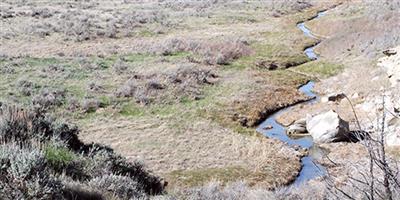
Scott Wessel and his mother, Pam, worked with NRCS to plan and implement at grazing management plan on their ranch near Lavina, Mont., that has had a positive impact on the Wessel’s cattle operation and improved wildlife habitat. |
Drive north of Lavina, Mont., and you will find the Wessel Ranch, but not much else. No other houses, cars or even power lines. What you will find are acres of open rangeland, more cattle than people, and sagebrush that creates perfect habitat for sage grouse.
The Wessel family bought the ranch in 2008 and started assessing what improvements were needed.
“It was obvious from the start that we were going to need more water,” said Scott Wessel, rancher. “We called NRCS (Natural Resources Conservation Service) to see what type of help we could get.”
NRCS did an inventory of the ranch, developing a grazing management plan with the Wessels that included a system for rotational grazing and stockwater tanks to support cattle in every unit.

A male Greater sage grouse struts and inflates his air sacs to attract females during an annual mating ritual on a lek near Lavina, Mont. |
 NRCS Chief Jason Weller, right, met with Scott Wessel on his ranch near Lavina, Mont., to see conservation practices installed to improve his grazing operation and sage grouse habitat. Also pictured is Austin Shero, left, NRCS district conservationist in Roundup, Mont., and Lisa Coverdale, NRCS state conservationist for Montana. |
 The Wessel Ranch near Lavina, Mont., provides excellent sage-grouse habitat: large, intact and mostly treeless landscapes with sagebrush, native bunchgrasses, wildflowers and wet meadows. |
Wessel said the conservation plan laid the ground work for everything that followed. “NRCS helped me map out everywhere water tanks would go and how the cattle would rotate,” he said.
In what Wessel referred to as phase one, he installed 12 water tanks and electric fence to divide pastures. After the first year under his new system, Wessel was pleased with the results. “Our goal is to have more grass and feed less hay.” Mission accomplished. “We produced 30 percent of the hay we normally do because of the drought, but because we had enough grass to graze year round, we did not run short on hay,” Wessel said.
He credits the rotational grazing system. “Our grass looks nearly as good when we leave a pasture as when we go into one.”
Converting marginal cropland to grazing land is another part of Wessel’s plan. Not only does that provide more grazing acres for his cattle, it also provides a benefit to wildlife in the area, particularly sage grouse.
According to Austin Shero, NRCS district conservationist in Roundup, cropland conversion is the number one detriment to sage grouse habitat in Montana. “Converting cropland to grassland helps with brood rearing, which is the most critical component to increasing sage grouse success rates,” he said.
In addition to cropland conversion, the Wessels also added wildlife friendly ramps in stockwater tanks to allow wildlife to escape, virtually eliminating wildlife mortality in stockwater tanks. The electric fence used to divide pastures also has a wildlife purpose – allowing wildlife to easily travel under or over the fence.
As Shero explains it, it’s about working lands for agriculture and working lands for wildlife.
That’s why, in 2010 when the Wessels applied for financial assistance through the Environmental Quality Incentives Program, their project was a perfect match for NRCS’s Sage Grouse Initiative, an effort to conserve sage-grouse and sustain the working rangelands that support ranching economies. Wessels were one of the first participants in an initiative that has invested nearly $300 million in nearly 1,300 contracts to conserve and improve sage grouse habitat on little over 5 million acres.
Ranchers’ efforts were a part of the reason the U.S. Fish and Wildlife Service (FWS) concluded in September 2015 that the Greater Sage Grouse does not warrant protection under the Endangered Species Act.
The Wessels agree with the U.S. Fish and Wildlife determination. “We have seen more sage grouse every year on our place,” Wessel said. “More elk and deer too.”
What are the Wessels’ future plans? They plan to convert more marginal cropland to grazing land, install water storage tanks to make water more readily available, add more stockwater tanks for cattle, and use electric fence to divide pastures to facilitate their rotational grazing system.
Wessel says the results have made him a believer. “We weaned heavier calves last year than we ever have and that’s with a year that delivered 65 percent of the moisture we generally receive,” he said. “We must be doing something right.”
Scott’s mom Pam has worked with Scott every step of the way. “I am proud of the joint effort and for everyone involved,” she said. “I feel so lucky standing here on our ranch, looking at all we’ve accomplished.”
Source: Montana NRCS


